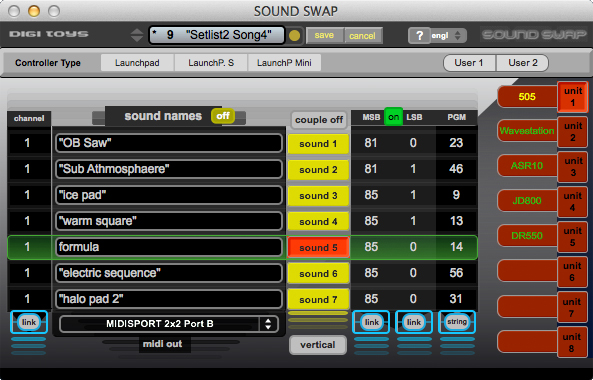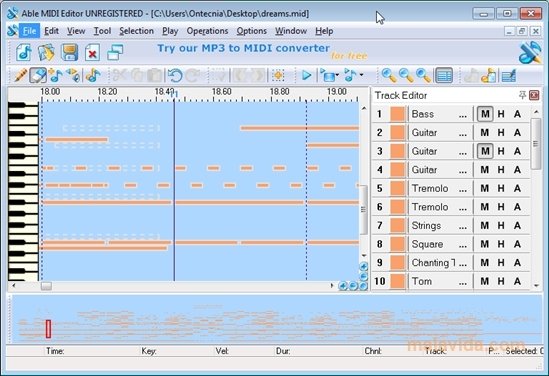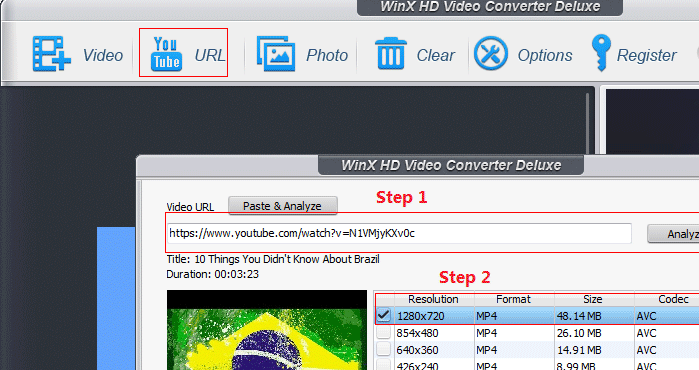Take creative control of your MIDI hardware with Midi Quest 12, the multi-instrument Editor/Librarian. Midi Quest supports over 830 MIDI devices and instruments with unparalleled editing and organizational tools including AU, AAX, VST3, VST2, and MFX plug-ins. The only editor/librarian to be rated '10' by Electronic Musician. Easily record, edit, sequence and mix MIDI files with MixPad MIDI Editing Software. Powerful studio quality MIDI music mixing tools for beginners and pros alike. Download for PC or Mac. Easy and powerful MIDI drum sequencer and GS/XG drum setup editor. Windows: Freeware: 2002-06-30: 21: 65db: Cherry Picker v2.62: Powerful MIDI patchfile editor. Mac: Free: 2005-09-28: 6: 60db: Bome's SendSX 1.30 Beta 3: Send and Receive arbitrary MIDI Data. Windows: Demo: 2013-02-18: 6: 60db: JUNO Librarian: Make libraries of voice data for.
Chrome download for mac os. Flash works fine in Safari and Firefox. Flash player no longer working in Google Chrome - Chrome Version 22.0.1229.79, Mac OS X Lion. None of these have fixed the problem.
- Appkats.Com
- Midi Editor Mac Free Download
- Best Free Midi Keyboard Software
- Cached
- See Full List On Hitsquad.com
Mac users interested in Midi editor for mac os x generally download: KAOSSILATOR PRO Editor 1.0 Free KAOSSILATOR PRO Editor is a dedicated software program for managing your recorded loop data.
The piano roll editor is the default Logic Pro MIDI editor. It has the most features and is designed for speed and complete control. Inspired by player pianos, which use grid-based punch cards to make music, this Logic Pro editor is user friendly and your go-to MIDI editor. To open Logic Pro’s piano roll editor, do one of the following:
- Double-click a MIDI region.
- Choose View → Show Editor or press E with a MIDI region selected.
- Choose Window → Open Piano Roll or press ⌘-4 to open the piano roll editor in a new window.
The score editor is the choice for notation and traditional music representation. It is great for composition and scoring, and is a requirement for getting your music played by other professional musicians. If you enjoy reading music, you’ll appreciate the score editor. To open the score editor, you can do any of the following:
- Double-click a MIDI region to open the MIDI editors, and then click the Score tab.
- Choose View → Show Editor with a MIDI region selected, and then click the Score tab or press N.
- Choose Window → Open Score Editor or press ⌘ -5 to open the score editor in a new window.
The step editor works well at building musical patterns, especially drum patterns. It mimics step sequencers, in which you build a sequence of notes by using a grid. Even though it’s grid-based like the piano roll editor, the step editor has a different layout that allows you to quickly edit MIDI event types other than notes, such as velocity or MIDI controller data. To open the step editor, do the following:


- Double-click a MIDI region to open the MIDI editors, and then click the Step Editor tab.
- Choose View → Show Editor with a MIDI region selected, and then click the Step Editor tab.
- Choose Window → Open Step Editor to open the step editor in a new window.
Appkats.Com
The event list editor might not be the most attractive MIDI editor, but it’s probably the most complete editor, listing every MIDI event you record. To open the event list editor, you can do one of the following:
- Choose View → Show List Editors with a MIDI region selected, and then click the Event tab or press D.
- Choose Window → Open Event List to open the event list editor in a new window or press ⌘ -7.
The MIDI environment used to be a more fundamental, and often intimidating, part of the Logic Pro workflow. With Logic Pro X, the environment has been pushed into the background, but you wouldn’t be able to sequence without it. The MIDI environment is integral to the input and output of your audio and MIDI. Do one of the following to open the MIDI environment:
- Choose Window → Open MIDI Environment to open the MIDI environment in a new window.
- Press ⌘ -0 to open the MIDI environment window.
Midi Editor Mac Free Download
The MIDI transform window alters your MIDI and can save you from time-consuming and repetitive editing tasks. Whenever you want to automate the transformation of large amounts of MIDI data, use the MIDI transform window. You can open the MIDI transform window in a couple of ways:
- Choose Window → Open MIDI Transform to open the MIDI Transform window in a new window.
- Press ⌘ -9 to open the MIDI transform window.

To enable the full MIDI editing features of Logic Pro X, you must have Show Advanced Tools selected in the Advanced Preferences pane. Choose Logic Pro X → Preferences → Advanced Tools, and then select Show Advanced Tools and the other additional options.
Best Free Midi Keyboard Software
Audio MIDI Setup User Guide
If you use MIDI devices or a MIDI interface connected to your Mac, you can use Audio MIDI Setup to describe the configuration of your MIDI devices. There’s a default configuration already created, but you can set up your own.
You can use this configuration information for apps that work with MIDI, such as sequencers, to control your MIDI devices.
Note: Make sure your MIDI devices are connected to your Mac. If you’re using an interface device, connect any other MIDI devices you’re using to the interface. Also check that any software provided by the manufacturer of the MIDI devices has been installed. For more information, see the documentation that came with your devices.
View a MIDI configuration

In the Audio MIDI Setup app on your Mac, choose Window > Show MIDI Studio.
In the MIDI Studio window, click the Choose MIDI Configuration pop-up menu (it may show Default), then choose the configuration you want to view.
In the toolbar, click the following buttons to change how the configuration is shown:
Hierarchical View : Devices in the configuration are shown as icons. If a device isn’t connected, its icon is dimmed. To view information about a device, such as channel properties and ports, and to add or remove ports, double-click the device’s icon.
List View : Devices in the configuration are shown in a list, organized by type (such as Interface or External Device). If a device isn’t connected, it’s dimmed. To filter which devices are shown, click the Show pop-up menu, then choose an option (such as Online or Connected). To view information about a device, double-click the device. To view its ports, or to connect or disconnect devices, click the device’s disclosure triangle.
Create a MIDI configuration
In the Audio MIDI Setup app on your Mac, choose Window > Show MIDI Studio.
In the MIDI Studio window, click the Choose MIDI Configuration pop-up menu (it may show Default), then choose New Configuration.
Enter a name for the new configuration, then click OK.
To add a new external MIDI device, click the Add button in the MIDI Studio toolbar.
This Free Mac YouTube Converter is an easy-to-use MP4 and MP3 converter. It is completely free, and helps you convert your YouTube video with super fast converting speed, provides you the easiest. Youtube to mp4 converter free download - Free YouTube Converter, MediaHuman YouTube to MP3 Converter, 4Media YouTube to iPod Converter, and many more programs. KeepVid YouTube to MP4 converter is a free online YouTube MP4 Converter, which allows you to convert and download YouTube videos to your device for offline watching. This YouTube MP4 Converter supports 1000 sites, such as Vimeo, Facebook Video, and many more. Just try it out. YouTube to MP4 Our YouTube to mp4 converter is the easiest way to convert YouTube videos to mp4 files online and download them for free. The videos will be always converted in the highest available quality. Unlike other websites, you can also convert videos that are blocked in your country.
 Wondershare Free Video Converter for Mac. Best Video Converter for Mac allows lossless quality.
Wondershare Free Video Converter for Mac. Best Video Converter for Mac allows lossless quality.To set properties and add or remove ports for the MIDI device, double-click the device, or select it, then click the Device Info button in the toolbar.
In the Properties window, do any of the following:
Describe the device: Enter a name for the MIDI device; the name appears in apps you use with the device. If you know the manufacturer and model, you can enter those.
Change the device icon: Click the MIDI device’s icon to open the Icon Browser, select a different icon to represent the device, then click the new icon to close the Icon Browser.
Change the device color: Click the color well, select a different color to use for the MIDI device, then close the Colors window.
Set the device channels and other properties: Click Properties, then click the channels to use for transmitting and receiving audio. To deselect a channel, click it again. Also select whether to use the MIDI Beat Clock, the MIDI Time Code, or both, then select other features.
Add or remove ports: Click Ports, click the Add button below the list of ports, then specify the MIDI In and MIDI Out connectors for the port. To delete a port, select it in the list, then click the Remove button .
Select MIDI-CI profiles for interface devices: If an interface device supports MIDI-CI, click MIDI-CI to see the profiles available on each channel. To turn a profile on or off, select or deselect its checkbox.
Click Apply.
Repeat steps 4 through 7 for each MIDI device you want to include in the configuration.
In the MIDI Studio window, specify the connection between MIDI devices:
In Hierarchical View , drag the In or Out connectors at the top of a device icon to the corresponding connector on another device icon.
In List View , click a device’s disclosure triangle, click the Port disclosure triangle, click the Add Connection icon, then use the pop-up menus to specify the connections.
If you have a MIDI interface connected to the USB port on your Mac, it should appear in the MIDI Studio window. If it doesn’t, see If a connected MIDI device isn’t shown.
Cached
You can’t specify a “MIDI thru” connection between two MIDI devices. To indicate a MIDI thru connection, connect the two MIDI devices to the same port of the MIDI interface device.

Edit a MIDI configuration
See Full List On Hitsquad.com
In the Audio MIDI Setup app on your Mac, choose Window > Show MIDI Studio.
In the MIDI Studio window, click the Choose MIDI Configuration pop-up menu (it may show Default), then choose Edit Configurations.
Select a configuration, then click Duplicate, Rename, or Delete.
When you’re finished making changes, click Done.
